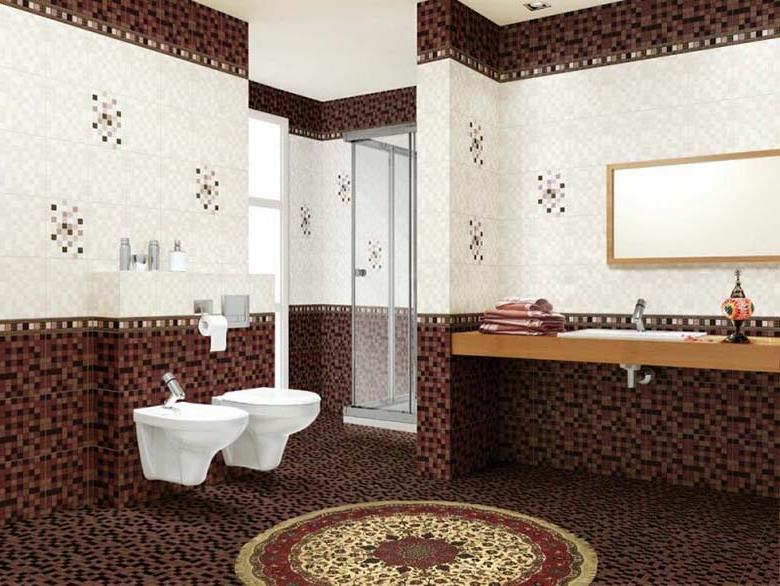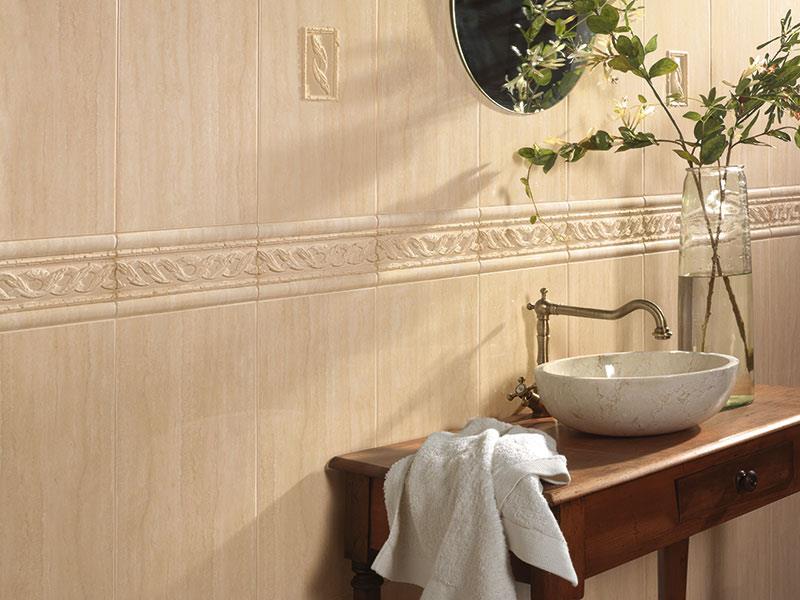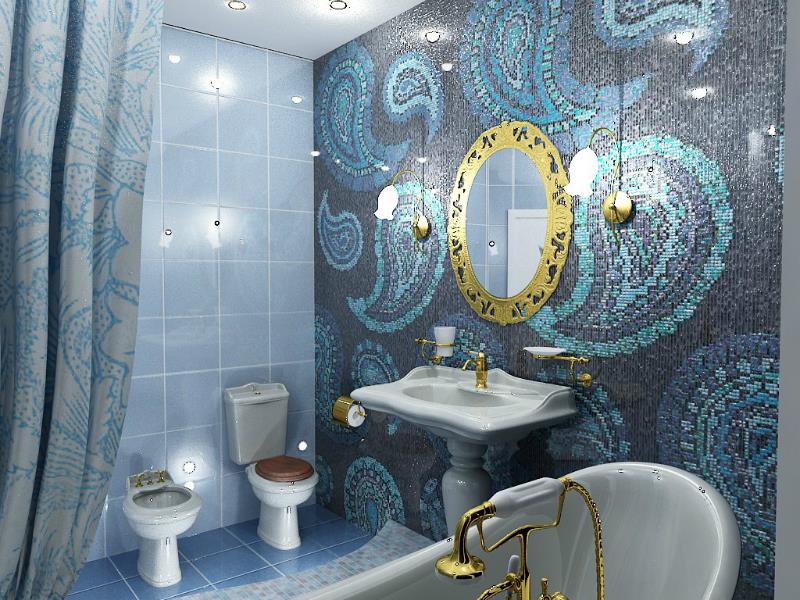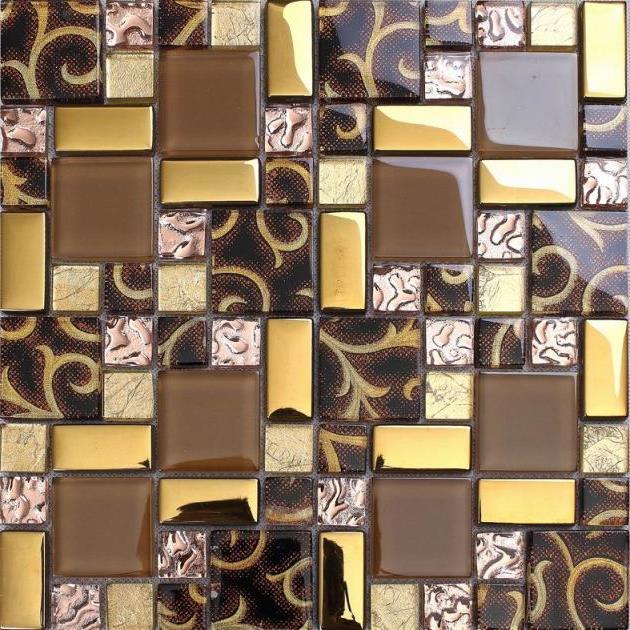Which tile is better to choose for the bathroom: expert advice
The bathroom is a room with a specific operational load, so the materials for its decoration must be chosen with great care.
Already at the stage of repair planning, you should decide on the main characteristics that will ensure comfort and the absence of problems in the future.
The bathroom is most often used ceramic tiles. This is due, first of all, to optimal consumer qualities - durability, resistance to high humidity and a rich range of design solutions.
But, even having decided that tiles will be used in the bathroom, there are a lot of questions, the main of which is which tile is better to choose for the bathroom? The choice should be based on three main components:
- Performance characteristics of tiles
- Design and texture
- Shape and size
Basic bathroom design principles
When choosing bathroom tiles among the collections, the flight of fantasy should be limited by common sense and the realities of the room - luxurious Renaissance-style panels and massive slabs imitating antique marble are not suitable for renovating a small bathroom.
You should adhere to the basic patterns of space design:
- the vertical pattern creates the feeling that the walls are higher and visually raises the ceiling;
- light colors expand the space, dark ones will make a small room even smaller;
- a large and expressive ornament gives the surface solidity, but visually reduces it;
- glossy surfaces create a feeling of spaciousness, but the glare that occurs under artificial lighting tires the eyesight.
Performance characteristics of tiles
The product label contains full information about its quality characteristics.
It is the marking on the packaging that will help you choose the best material. According to international standards, manufacturers designate characteristics in the form of pictograms.
The main nuances when choosing a coating for bathrooms are.
- Resistant to temperature changes and water vapor.
- Appointment. Depending on which surface the tile is suitable for facing, the manufacturer puts a pictogram in the form of a silhouette of a foot (for the floor) or a palm print (for walls).
- The thickness of the tile is also marked with a pictogram. For wall decoration, the material is optimal, the thickness of which is 6-9 mm, for the floor - 9-12 mm.
- Strength. Depends on the number of firings. Products that have been fired once are more durable, they can be used for flooring. This indicator is marked with a pictogram of the silhouette of flames, inside of which there is a number corresponding to the number of firings.
- The anti-skid coefficient is marked with an icon in the form of a silhouette of a boot, which stands on an inclined plane, its indicator varies in the range from 1 to 4.
- Resistance to the action of household chemicals is indicated by a pictogram in the form of a silhouette of a flask and Latin letters. The letters of the Latin alphabet are used to indicate the level of chemical resistance. For the bathroom, it is best to choose products marked with the “AA” symbol, which guarantees the highest degree of stability,
- Abrasion resistance. This characteristic is marked with a sharp-toothed gear symbol. There are five classes of products in terms of resistance to abrasion, depending on the operational load. The first includes the softest tiles, suitable exclusively for wall decoration, the fifth - products that will be used in industrial premises with high traffic. For flooring in a home bathroom, a second wear resistance class is recommended - few people will walk on the floor and mostly barefoot or in shoes with soft soles. Bathroom floor tiles must be scratch resistant.
In order to choose the optimal tile, it is necessary to understand the types and classifications that are responsible for one or another characteristic of the material.
 When buying tiles, pay attention to the coefficient of anti-slip and abrasion resistance
When buying tiles, pay attention to the coefficient of anti-slip and abrasion resistance Types of tiles
Depending on the manufacturing method, there are several types of ceramic tiles:
- bicottura- material that has been fired twice. Usually produced glazed. Resistant to detergents. however, it does not differ in high strength, therefore it is suitable for exclusively wall decoration.
- Monocottura undergoes a single firing. This is a more durable material that can also be used for flooring. However, if the material is glazed, its resistance to abrasion is reduced and it is used only for walls.
- Clinker is the most durable ceramic tile option. Thanks to a special production technology, the material is low-porous and very durable. Its disadvantage is the limited design, the clinker has natural shades.
- Porcelain stoneware is a particularly durable type of floor tile, characterized by high resistance to abrasion and scratching. Traditionally, the surface is made under a stone, imitation of a granite cut, marble and other natural materials. The rough surface ensures minimal slippage, which is a big advantage in high humidity areas.
 On the walls of the bathroom we lay the tiles "bicottura" with double firing
On the walls of the bathroom we lay the tiles "bicottura" with double firing In addition to ceramic tiles for bathroom cladding, the following are used:
- Glass and mirror tiles. The durability and moisture resistance of these materials is almost the same as that of ceramics, however, glass is even more susceptible to impact loads. therefore suitable exclusively for decorating walls and ceilings.
- Polymer tiles. PVC tile is a cheap finishing option. It is not as durable as ceramics, but has a greater variety of designs, so it is in demand when carrying out budget repairs.
- Natural stone tiles. Luxurious, almost eternal material, the disadvantage of which is its extremely high price.
How to choose a quality tile?
In addition to the important issues of optimal technical indicators of tiles declared by the manufacturer, one also has to deal with issues of quality and defective products. To choose a quality tile, you need to pay attention to several points.
Tile absorbency
In the event that the tile absorbs moisture strongly, over time, its weight may increase so much that the adhesive will not hold it on the wall, and it will fall off. In addition, the front coating may also suffer, cracks and spots on the enamel will appear. It is easy to identify a tile that absorbs moisture strongly on the wrong side - it has small pores. Ideally, they should not be at all, but if there are few of them (up to 10 pieces), you can buy tiles.
Reverse side flatness
In the event that a depression forms in the center of the plate, it will not be sufficiently filled with glue, and a void will form there, into which moisture will enter during operation. As a result, the relationship between adhesive and tile will decrease and gradually break down, and after a few years, the tile may begin to move away from the wall. You can evaluate the evenness of a tile by folding two tiles with their faces to each other and checking for a gap between them.
Front surface quality
It is determined by several characteristics. If you run your palm over the gloss, it should be perfectly smooth, if there are roughness, this indicates the use of outdated technologies. Traces of bubbling also indicate a poor-quality product. The second important indicator is the uniformity of color, a quality product should be painted evenly.
stable geometry
It is impossible to qualitatively lay a tile with distortions and violations of geometry, primarily because it will not be possible to maintain the evenness of the seam.
You can check the geometry of the tiles as follows. A stack of tiles is installed standing on a flat surface while standing. If the top edge is a fan, even with minimal differences, this tile is of poor quality. This is either a factory marriage, or products from different batches.
Shape and size
The size of the tile is important not only from an aesthetic point of view. There are also functional features that should be considered when choosing a material. So, with a complex configuration of the room, it is better to give preference to small tiles or mosaics, since large tiles will often have to be cut and this will entail waste of material.
At the same time, the joints between the tiles are the most vulnerable point for water penetration, and even if they are treated with high-quality grouts, mold can begin to form under conditions of constant high humidity. In this regard, larger tiles, which will have fewer seams, are more advantageous.
 For complex patterns, we lay mosaics or small tiles
For complex patterns, we lay mosaics or small tiles Bathroom color scheme
The color scheme comes to the fore when asked which tile to choose for a small bathroom. The right combination of shades can significantly improve the visual perception of space.
All kinds of shades of water and marine motifs are very popular in the design of bathrooms. The tile of the color of light shades of the sea wave and delicate azure colors looks beautiful and not stereotyped.
However, designers note that the blue scale is cold, and its saturated tones can have a depressing effect on the psyche. In order to minimize this effect, decorators resort to color combinations. Blue shades are especially good in combination with gold and white.
In small rooms, blue colors should be preferred, blue colors can visually reduce the space.
Also, the classic design option for the bathroom is green. This is quite justified - greenery is associated with the natural freshness of grasses and meadows. Light green and pistachio colors are ideal for walls, creating a joyful cheerful mood, but the favorite malachite and emerald tiles are best left for the floor or used in combination with shades of white.
The classic combination of black and white tiles is still relevant and stylish. However, this design visually reduces the area of \u200b\u200bthe room, so experts recommend it only for spacious bathrooms.
For a small bathroom, a color scheme is suitable, in which the walls are solved in white, and black, or blotches of black, are used only in the design of the floor.
In modern interiors, you can increasingly find bathrooms made in red colors. To make the bathroom look stylish, but at the same time harmonious, several rules should be considered.
In small rooms, red can be used locally, decorating only some areas with it, for example, highlighting the washbasin or mirror area. For the floor, it is better to choose rich burgundy shades or bright coral tiles. In spacious rooms, red can be used on a larger scale.
However, regardless of the size of the bathroom, designers recommend using it in combination with other colors. The combination of red tiles with white in the design of a suitable decor looks very elegant. Raspberry or ruby colors are perfectly set off by gray or silver colors, especially if mother-of-pearl tiles are chosen. A bathroom decorated in pink and white with golden decor can look very gentle and elegant.
With the help of shades of orange, you can create a joyful sunny design. Designers recommend placing a rich orange color locally, using calm beige or peach tones as a base.
 We carefully approach the issue of choosing a design and color scheme for the bathroom
We carefully approach the issue of choosing a design and color scheme for the bathroom The floor is best decorated with tiles in warm shades of chocolate or wenge. Such a lining will not be overly colorful, it will set you up for rest and relaxation.
Lilac and shades of purple, combined with floral decor, are suitable for creating romantic and feminine interiors.
If you complement these colors with cold gray shades and choose a decor with laconic stripes or an abstract pattern, the interior will sparkle in a different way, acquiring notes of modern and hi-tech.
- When choosing a tile color scheme for a small bathroom, it is always better to give preference to light colors. Dark shades are only suitable for floor tiles.
- Dark glossy tiles look very impressive, but require careful maintenance. It shows the slightest traces of dried splashes of water, prints of wet feet, every speck of dust. If it is not possible to wash the walls at least once a week and wash the floors several times a day, it is better to refuse the choice of dark glossy tiles in the bathroom. Matte tiles, especially imitating the natural surface of the stone, are many times more practical.
- With a complex architecture of the room, it is best to decorate the room with tiled mosaics.
- Too many colors in the interior of the bathroom is unacceptable, two or three shades are enough. Otherwise, an annoying variegation will appear, which has an exciting effect on the psyche.
- Bright colors should accentuate individual elements of the interior, but not make them basic.
The time spent on studying and choosing the optimal tile is more than compensated by the incomparably longer service life of a quality coating.






